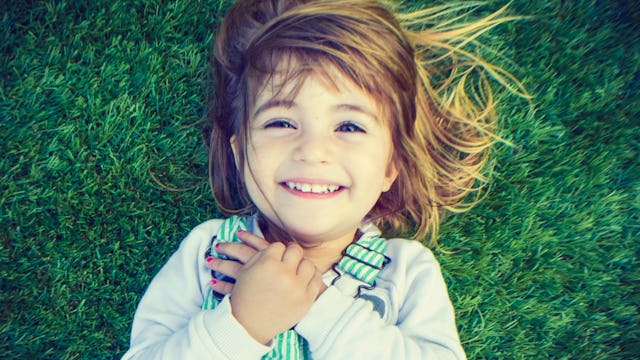A Mindfulness Program Could Be The Secret To Helping Our Children Be Happier

“Give it back!” My six-year-old daughter screamed at her brother in the other room. “No, it’s mine!” he yelled back.
And then silence. An ominous silence.
It was ominous because I was waiting for, I don’t know, more yelling or a violent crash or cursing in a foreign language or something. That’s the way “give it back” and “no, it’s mine” usually ends.
Curious and partly afraid of the silence, I went to see what was going on. My daughter was sitting on the floor in her room by herself, nostrils flaring. She was obviously still mad. But she had her hand clutched into a fist and placed on her stomach, which was puffing in and out with her breathing.
“What’s up?” I said.
“I’m mad at him,” she said.
“I can see that. But, um, what are you doing?”
“I’m popping the mad bubbles.”
Mad bubbles?
Slowly, her breathing slowed down. Her nostrils lost their flare. She seemed calmer.
Then, it clicked for me. I knew exactly what she was doing. And it was fricking working.
At the beginning of 2016, our town’s elementary school began a pilot program for teaching mindfulness called Reboot. The program is a series of pre-recorded guided mindfulness sessions that the kids listen to each morning over the loudspeaker.
In the recordings, Patti Schrader, one of the founders of Reboot, runs the kids through some super simple exercises. These can include breathing, visualization, gratitude, and, yes, popping emotional bubbles. She ends each session with telling the kids to go out and, “Rock their day.” It’s only three minutes of each day, but it’s making all the difference for the kids in our school.
Reboot’s website describes mindfulness like this, “Mindfulness is a brain exercise where the person focuses on a single object—your breath, sounds around you, or even chewing your food. This act of “being present” and focus can recalibrate the brain.”
Yes, you can actually change the physical formation of your brain when you regularly practice mindfulness. One of the specific areas that gets changed is your fight or flight center, or the amygdala. The amygdala is our body’s command center for dealing with stress and it physically shrinks when a person regularly practices mindfulness. Whereas, the prefrontal cortex, which is responsible for decision-making and awareness becomes thicker.
Less stress and better awareness and decision-making = happier kids.
My fifth grader, who has been listening to the Reboot recordings for two years now, tells me that his favorite parts are the fun things that Patti tells them to do throughout the day. Things that can help them focus on being inside their bodies, present, aware of little moments. The things that have been proven to change the shapes of our brains.
“Every time you feel the sun on your skin say, “WooHoo!”
“Find a person in the hallway that you don’t know that well and give them a high-five.”
“Every time you take a drink of cold water, think about how cold it is.”
It’s teaching our kids to connect. With themselves and with others. With the world. In simple, three-minute sessions.
Here is a video of our school and how Reboot is being implemented here.
Reboot’s mindfulness products use “scientifically backed, secularized techniques learned from meditation that are tested using biofeedback. Our tools are built specifically for mainstream administration of mindfulness training.”
Yes, the effectiveness of teaching mindfulness to all kinds of humans has been proven in study after study after study.
And it can help kids learn to cope after tragedies, which are happening way too often in our schools these days. According to Reboot’s website, “Las Vegas schools are using Reboot to deal with the emotional stress as the community heals from the largest mass shooting in US history.”
All of these things are teaching our kids to be present. It’s teaching them to calm the chattering voices in their heads. It’s teaching them things that it took me until my 30s to learn. And it’s working in our school. The kids are talking about their feelings more. Incidences of the more violent behaviors has decreased drastically. My six-year-old knows how to pop mad bubbles. I don’t even think I know how to pop mad bubbles.
If you’re interested in starting Reboot in your own school, go here.
Be the one who makes this positive change in your child’s school. Your kids, and the future adults they will become, will thank you.
Editors may receive samples and/or a share from purchases made via links on this page. All opinions are our own.
This article was originally published on